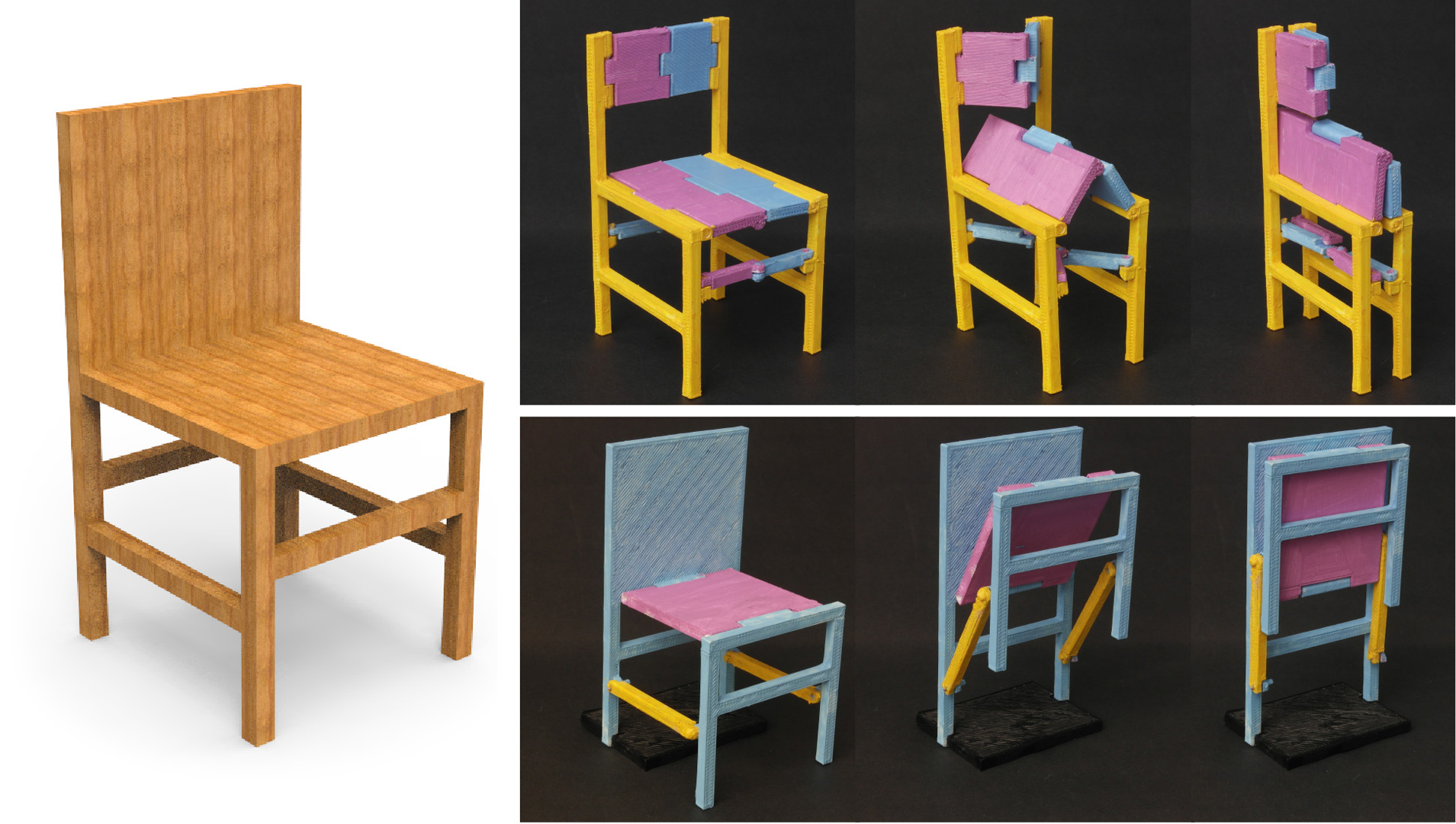“Foldabilizing furniture”
Conference:
Type(s):
Title:
- Foldabilizing furniture
Session/Category Title: Fabricating Fabulous Forms
Presenter(s)/Author(s):
Moderator(s):
Abstract:
We introduce the foldabilization problem for space-saving furniture design. Namely, given a 3D object representing a piece of furniture, our goal is to apply a minimum amount of modification to the object so that it can be folded to save space — the object is thus foldabilized. We focus on one instance of the problem where folding is with respect to a prescribed folding direction and allowed object modifications include hinge insertion and part shrinking.We develop an automatic algorithm for foldabilization by formulating and solving a nested optimization problem operating at two granularity levels of the input shape. Specifically, the input shape is first partitioned into a set of integral folding units. For each unit, we construct a graph which encodes conflict relations, e.g., collisions, between foldings implied by various patch foldabilizations within the unit. Finding a minimum-cost foldabilization with a conflict-free folding is an instance of the maximum-weight independent set problem. In the outer loop of the optimization, we process the folding units in an optimized ordering where the units are sorted based on estimated foldabilization costs. We show numerous foldabilization results computed at interactive speed and 3D-print physical prototypes of these results to demonstrate manufacturability.
References:
1. Baird, J. C. 1970. Psychophysical analysis of visual space. New York: Pergamon Press.Google Scholar
2. Bennell, J. A., and Oliveira, J. F. 2008. The geometry of nesting problems: A tutorial. European Journal of Operational Research 184, 2, 397–415.Google ScholarCross Ref
3. Demaine, E. D., and O’Rourke, J. 2007. Geometric Folding Algorithms: Linkages, Origami, Polyhedra. Cambridge University Press. Google ScholarDigital Library
4. Jackson, P. 2011. Folding Techniques for Designers: From Sheet to Form. Laurence King Publishing.Google Scholar
5. Kilian, M., Flöry, S., Chen, Z., Mitra, N. J., Sheffer, A., and Pottmann, H. 2008. Curved folding. ACM Trans. on Graph 27, 3, 75:1–75:9. Google ScholarDigital Library
6. Koo, B., Li, W., Yao, J., Agrawala, M., and Mitra, N. J. 2014. Creating works-like prototypes of mechanical objects. ACM Trans. on Graph 33, 6 (Nov.), 217:1–217:9. Google ScholarDigital Library
7. Lau, M., Ohgawara, A., Mitani, J., and Igarashi, T. 2011. Converting 3D furniture models to fabricatable parts and connectors. ACM Trans. on Graph 30, 4, 85:1–85:6. Google ScholarDigital Library
8. Li, X.-Y., Shen, C.-H., Huang, S.-S., Ju, T., and Hu, S.-M. 2010. Popup: automatic paper architectures from 3d models. ACM Transactions on Graphics 29, 4, 111:1–9. Google ScholarDigital Library
9. Li, X.-Y., Ju, T., Gu, Y., and Hu, S.-M. 2011. A geometric study of v-style pop-ups: Theories and algorithms. ACM Transactions on Graphics 30, 4, 98:1–10. Google ScholarDigital Library
10. Li, H., Alhashim, I., Zhang, H., Shamir, A., and Cohen-Or, D. 2012. Stackabilization. ACM Trans. on Graph 31, 6, 158:1–158:9. Google ScholarDigital Library
11. Lodi, A., Martello, S., and Monaci, M. 2002. Two-dimensional packing problems: A survey. European Journal of Operational Research 141, 2, 241–252.Google ScholarCross Ref
12. Luo, L., Baran, I., Rusinkiewicz, S., and Matusik, W. 2012. Chopper: Partitioning models into 3D-printable parts. ACM Trans. on Graph 31, 6, 129:1–129:9. Google ScholarDigital Library
13. McArthur, M., and Lang, R. J. 2013. Folding Paper: The Infinite Possibilities of Origami. Turtle Publishing.Google Scholar
14. Mollerup, P. 2001. Collapsible: The genius of space-saving design. Chronicle, San Francisco, Calif.Google Scholar
15. Niskanen, S., and Östergård, P. R. J. 2003. Cliquer user’s guide, version 1.0. Tech. rep., Helsinki University of Technology, Espoo, Finland.Google Scholar
16. Norman, J. F., Todd, J. T., Perotti, V. J., and Tittle, J. S. 1996. The visual perception of three-dimensional length. Journal of Experimental Psychology: Human Perception and Performance 22, 1, 173–186.Google ScholarCross Ref
17. Östergård, P. R. J. 2001. A new algorithm for the maximum-weight clique problem. Nordic J. of Computing 8, 4, 424–436. Google ScholarDigital Library
18. Pottmann, H., Asperl, A., Hofer, M., and Kilian, A. 2007. Architectural Geometry. Bentley Institute Press.Google Scholar
19. Ruiz Jr., C. R., Le, S. N., Yu, J., and Low, K.-L. 2014. Multistyle paper pop-up designs from 3d models. Computer Graphics Forum (Special Issue of Eurographics). Google ScholarDigital Library
20. Saul, G., Lau, M., Mitani, J., and Igarashi, T. 2011. Sketchchair: An all-in-one chair design system for end users. In Proc. of Int. Conf. on Tangible, Embedded, and Embodied Interaction, 73–80. Google ScholarDigital Library
21. Schmidt, R., and Ratto, M. 2013. Design-to-fabricate: Maker hardware requires maker software. IEEE Computer Graphics and Applications 33, 6, 26–34. Google ScholarDigital Library
22. Schulz, A., Shamir, A., Levin, D., Sitthi-Amorn, P., and Matusik, W. 2014. Design and fabrication by example. ACM Trans. on Graph 33, 4. Google ScholarDigital Library
23. Umetani, N., Igarashi, T., and Mitra, N. J. 2012. Guided exploration of physically valid shapes for furniture design. ACM Trans. on Graph 31, 4, 86:1–86:11. Google ScholarDigital Library
24. Zhou, Y., Sueda, S., Matusik, W., and Shamir, A. 2014. Boxelization: Folding 3D objects into boxes. ACM Trans. on Graph 33, 4. Google ScholarDigital Library




